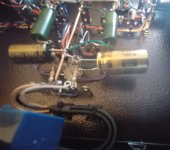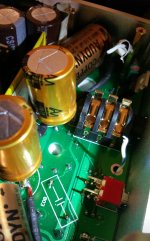Hi Guys
Has anyone tried polar & non polar kaisei caps ?
Curious how they sound, not cheap so wondering if they’re worth trying.
Thanks
Has anyone tried polar & non polar kaisei caps ?
Curious how they sound, not cheap so wondering if they’re worth trying.
Thanks
Despite of it's invention in the U.S., snake oil is no longer proprietary to a certain country 🙂!
Best regards!
Best regards!
I have tried AN Kaisei in various applications. In general these are excellent caps. I found they have a natural and transparent sound, especially in the mid-range.
Having said that different components suit different circuits. For example, I have success in applying Kaisei caps in cathode bypass, high (B+) & low voltage (digital) power supply (final cap). However it didn't work well in two different dc tube filament supplies I tried.
So one needs to experiment to find out if it works well or not.
Having said that different components suit different circuits. For example, I have success in applying Kaisei caps in cathode bypass, high (B+) & low voltage (digital) power supply (final cap). However it didn't work well in two different dc tube filament supplies I tried.
So one needs to experiment to find out if it works well or not.
Hi Jack
Thanks for the reply. Yes I too notice that 1 cap cannot be for all applications hence my projects are all finished with a mix of many different brands of caps.
Btw re comments, are they for polar or non polar An Kaisei caps ?
Cheers
Thanks for the reply. Yes I too notice that 1 cap cannot be for all applications hence my projects are all finished with a mix of many different brands of caps.
Btw re comments, are they for polar or non polar An Kaisei caps ?
Cheers
Btw re comments, are they for polar or non polar An Kaisei caps ?
Cheers
I have used both types but didn't compare them in the same position as I don't have the same value in both polar and non-polar types.
For cathode bypass I used non-polar type. I even tried the so called super-ecap topology (two non-polar in parallel in opposite orientation, a technique often used in non-polar Blackgate caps) and liked it even better than a single non-polar cap. I asked AN about this and surprisingly they don't think it will sound better ... well I heard what I heard so I kept it that way.
Other caps I like are Mundorf HV/AG series for high voltage (very smooth sounding) and Mundorf Silver-in-Oil (adds air and sparkle, good for bypassing AN Kaisei in cathode bypass).
Of course there is Duelund which is the most transparent for signal coupling but way expensive.
Hi Jack
Thanks again for your views. I think it’s all about where the caps are being used. I did try the Super E config with BG N as dc blocking but I didn’t like what I heard. I used to be a
die heart BG guy but now I no longer am a fan, perhaps its due to improved listening experience. Yes BG does bring something that no other caps can but it too is not that transparent . Will order some AN Kaisei to try. Thanks again for sharing. Btw is it cheaper to
purchase in HK as compared to say Hifi collective ?
Cheers
Thanks again for your views. I think it’s all about where the caps are being used. I did try the Super E config with BG N as dc blocking but I didn’t like what I heard. I used to be a
die heart BG guy but now I no longer am a fan, perhaps its due to improved listening experience. Yes BG does bring something that no other caps can but it too is not that transparent . Will order some AN Kaisei to try. Thanks again for sharing. Btw is it cheaper to
purchase in HK as compared to say Hifi collective ?
Cheers
Hi Jack
Will order some AN Kaisei to try. Thanks again for sharing. Btw is it cheaper to
purchase in HK as compared to say Hifi collective ?
Cheers
I bought mine through either Hifi collective or Partsconnexion, depending on who has the better deal at the time. FYI the latter has shipping promotion this month.
I have used both types but didn't compare them in the same position as I don't have the same value in both polar and non-polar types.
For cathode bypass I used non-polar type. I even tried the so called super-ecap topology (two non-polar in parallel in opposite orientation, a technique often used in non-polar Blackgate caps) and liked it even better than a single non-polar cap. I asked AN about this and surprisingly they don't think it will sound better ... well I heard what I heard so I kept it that way.
Other caps I like are Mundorf HV/AG series for high voltage (very smooth sounding) and Mundorf Silver-in-Oil (adds air and sparkle, good for bypassing AN Kaisei in cathode bypass).
Of course there is Duelund which is the most transparent for signal coupling but way expensive.
What value caps did you use in super e config. for cathode bypass?
Tried Audionote and they were nice but I felt a bit thicker in sound, so went to Nichion muse for cathode caps as they most balanced and clear for me.
I used Audionote in cathode caps position and they worked very well, just a little bit on the thick side.
I eventually used Nichion Muse in the cathode cap position, as those sounded most clear and balanced.
I eventually used Nichion Muse in the cathode cap position, as those sounded most clear and balanced.
I used Audionote in cathode caps position and they worked very well, just a little bit on the thick side.
I eventually used Nichion Muse in the cathode cap position, as those sounded most clear and balanced.
How interesting. In the same position, but obviously in a different system the Kaisei sound completely different to me. Very slightly on the cold side, but so revealing. Cannot think of anything better among currently produces caps.
Tried Audionote and they were nice but I felt a bit thicker in sound, so went to Nichion muse for cathode caps as they most balanced and clear for me.
Are you using bipolar or polar Kasei caps ?
My fault for not being clear.
The problem was thatI used non-polarized kasise version on a $3k amp.
It was at higher capacitance, wich altered the cicuit to produce more low end, so not all kasie cap fault, as much as the circuit fault.
(I uploaded in first pic)
So I also tried and ended up keeping the same value Nichion muse, which in that situation was more neutral.
I had used the kasie polarized version before successfully, on a cheaper amp ($200 appj) , using same method of increased capacitance, but way higher, from 200uf, to 1000uf, for more bass sustain.
The result was only a little more bass on this circuit, and totally transparent sound.
I then placed bypass caps, which ended up doing very little to top end(!).
Almost no change, which made me believe the kaisie were excellent and why I tried on the other amp.
The issue was that they were sold out of the polarized version at the time, so I tried the non-polarized, which as I just stated, didn't work out for me to be as transparent.
My mistake was in not using the polarized, and not realizing the circuit will behave differently on every amp.
I uploaded pics of the circuits below.
🙂
The problem was thatI used non-polarized kasise version on a $3k amp.
It was at higher capacitance, wich altered the cicuit to produce more low end, so not all kasie cap fault, as much as the circuit fault.
(I uploaded in first pic)
So I also tried and ended up keeping the same value Nichion muse, which in that situation was more neutral.
I had used the kasie polarized version before successfully, on a cheaper amp ($200 appj) , using same method of increased capacitance, but way higher, from 200uf, to 1000uf, for more bass sustain.
The result was only a little more bass on this circuit, and totally transparent sound.
I then placed bypass caps, which ended up doing very little to top end(!).
Almost no change, which made me believe the kaisie were excellent and why I tried on the other amp.
The issue was that they were sold out of the polarized version at the time, so I tried the non-polarized, which as I just stated, didn't work out for me to be as transparent.
My mistake was in not using the polarized, and not realizing the circuit will behave differently on every amp.
I uploaded pics of the circuits below.
🙂
Last edited:
I posted a clarification Post with details but website delaying post.
Maybe because I uploaded pics.
Long story short, my results were because of using the non-polarized, in combination with using increased value which alter the output in a Cathode cap position.
Maybe because I uploaded pics.
Long story short, my results were because of using the non-polarized, in combination with using increased value which alter the output in a Cathode cap position.
I try to upload pics but not work.
Anyways, I think they are as good as the other top brands.
I personally feel biased to getting the Nichion kz/muse for a more neutral, and the kasie over any other for more low end, but circuit matters alot.
I can only say the polarized version was just as transparent.
Anyways, I think they are as good as the other top brands.
I personally feel biased to getting the Nichion kz/muse for a more neutral, and the kasie over any other for more low end, but circuit matters alot.
I can only say the polarized version was just as transparent.
Attachments
I meant to say the polarized version was as transparent as my nichicon (overall from memory)
but the direct comparison of the non-polarized was not same result.
a
An so it had an added layer of weight over the mids to low end.
The trebles never were a problem, but I remember it being a bit laid back in that circumstance only.
I was comparing right and left sides to each other.
🙂
but the direct comparison of the non-polarized was not same result.
a
An so it had an added layer of weight over the mids to low end.
The trebles never were a problem, but I remember it being a bit laid back in that circumstance only.
I was comparing right and left sides to each other.
🙂
My mistake was in not using the polarized
This is interesting. I only have experience with the polarised types but have heard controversial opinions about the bipolars. Perhaps they are not as good.
- Home
- Design & Build
- Parts
- Audio Note Kaisei capacitors

